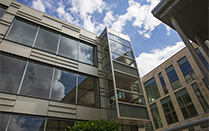
IMPROVING CAMPUS INFRASTRUCTURE
Some of the major improvements to infrastructure completed over the summer are very visible; others are not. Read in this issue about the many major projects completed by Physical Facilities and Information Technology Services, as well as the new programs offered by the University Center for Training and Development.
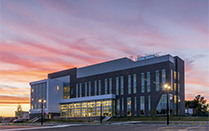
SCHOOL OF PHARMACY AND PHARMACEUTICAL SCIENCES OPENS NEW BUILDING
The opening of the new, $60-million School of Pharmacy and Pharmaceutical Sciences at the University's Health Sciences Campus in Johnson City, N.Y., headlines this quarterly report, but there's also good news about collaborations, external funding and student successes. Read more in this issue.
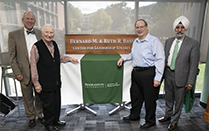
SUCCESSFUL INITIATIVES SUPPORT STUDENTS
It takes donors at many levels to make Binghamton University successful, and in this issue of the quarterly report, you can read about a number of them. Whether it's AVANGRID offering full-tuition scholarships and capstone project support, or playing golf to benefit the Alumni Legacy Scholarship, the Division of Advancement works with Binghamton supporters.
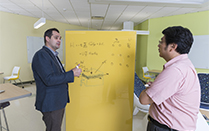
BINGHAMTON RESEARCH FUNDING SETS RECORD
Binghamton University reported research expenditures totaling $47.5 million in 2017-18, an increase of about 19 percent from the previous fiscal year. The figure tops 2011-12, the campus’ all-time best year for research funding, when just over $40 million was reported. The new record, which follows several years of steady growth, is an important sign of the campus’ creativity and innovation. Healthcare research accounted for nearly a third of expenditures, with electronics packaging and systems engineering following at about 22 percent.

BAXTER THE BEARCAT BOOSTS SCHOOL SPIRIT
The Division of Student Affairs spent the summer hosting students and families for orientation and preparing for the opening of the fall semester. With some new people on board and some others with new duties, it has been a busy time. Not too busy, though, to show Binghamton University pride, as you'll read about the new Baxter the Bearcat Bench in the University Union in this issue.
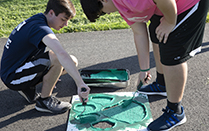
STUDENT-ATHLETES CONTINUE TO SUCCEED ACADEMICALLY
Student-athletes continue to shine on and off the courts and fields. The Athletics Department sets high academic standards, and student-athletes surpass them across the board. Read about the accomplishments made by student-athletes in their sports and in the classroom – and check out the videos showcasing fall sports and the new women's head basketball coach, Bethann Shapiro Ord, in this issue.

HELPING TO MAKE THE CAMPUS MORE INCLUSIVE
The Division of Diversity, Equity and Inclusion works to educate and empower everyone on campus in ways that create a welcoming community. From the Udiversity Educational Institute, that holds trainings for students, faculty and staff, to the Multicultural Resource Center and Q Center, the division's offices that work to build bridges and support students though education and events such as Sundaze, part of its Welcome Week programming. Read about the division's recent initiatives in this report.
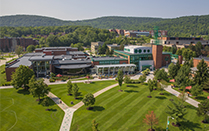
DONOR SUPPORT ADVANCES BINGHAMTON UNIVERSITY
The Binghamton University Foundation had a successful 2017-18 year, bringing in the second highest amount of cash ever in support of the University. Read the numbers in this issue of the quarterly report, and learn one way the Foundation celebrates its donors.
Senior Survey data gathering
Collection of information about career path destinations and outcomes grows as does response rates. Although the Senior Survey officially closed on June 30, Student Affairs Assessment and Strategic Initiatives (SAASI) and partners within each school continue to reach out to recent graduates. Rather than focusing on a high survey response, focuse was placed on a high “knowledge” response, since knowledge can come from a variety of sources and can be more effective to manage than repeated requests to answer a survey.
Working with colleagues who are more closely connected through fewer degrees of separation to a graduate (e.g. advisors, residential life staff, faculty) than a scripted survey allowed us to reach our goal of surpassing last year’s high 72 percent response rate. We also expanded the response rate competition to include the residential communities and certain programs such as EOP. This year the College of Community and Public Affairs had 100 percent response rate, followed closely by the Decker School of Nursing, the School of Management and the Thomas J. Watson School of Engineering and Applied Science. Harpur College of Arts and Sciences increased its response rate 67 percent to 75 percent, which helped the overall response rate increase to 82 percent.
SAASI continues to gather information for those students who, by June 30, 2014, had not found employment or were not enrolled in another program. The report on this information will be made available in November 2014, once all of the data is compiled and analyzed. SAASI works with each school and the Fleishman Center for Career and Professional Development to make sure that the information is presented in formats that are useful. This past summer an undergraduate student was hired who developed an interactive data visualization of the 2013 information that will be shown to each school for feedback to help determine how best to present this information in the future.
Preliminary analysis of the at-time-of-graduation data shows that our career outcome rate (aka placement rate) for both those seeking employment or continuing their education has increased.